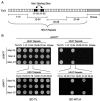ATM activation and its recruitment to damaged DNA require binding to the C terminus of Nbs1
- PMID: 15964794
- PMCID: PMC1156989
- DOI: 10.1128/MCB.25.13.5363-5379.2005
ATM activation and its recruitment to damaged DNA require binding to the C terminus of Nbs1
Abstract
ATM has a central role in controlling the cellular responses to DNA damage. It and other phosphoinositide 3-kinase-related kinases (PIKKs) have giant helical HEAT repeat domains in their amino-terminal regions. The functions of these domains in PIKKs are not well understood. ATM activation in response to DNA damage appears to be regulated by the Mre11-Rad50-Nbs1 (MRN) complex, although the exact functional relationship between the MRN complex and ATM is uncertain. Here we show that two pairs of HEAT repeats in fission yeast ATM (Tel1) interact with an FXF/Y motif at the C terminus of Nbs1. This interaction resembles nucleoporin FXFG motif binding to HEAT repeats in importin-beta. Budding yeast Nbs1 (Xrs2) appears to have two FXF/Y motifs that interact with Tel1 (ATM). In Xenopus egg extracts, the C terminus of Nbs1 recruits ATM to damaged DNA, where it is subsequently autophosphorylated. This interaction is essential for ATM activation. A C-terminal 147-amino-acid fragment of Nbs1 that has the Mre11- and ATM-binding domains can restore ATM activation in an Nbs1-depleted extract. We conclude that an interaction between specific HEAT repeats in ATM and the C-terminal FXF/Y domain of Nbs1 is essential for ATM activation. We propose that conformational changes in the MRN complex that occur upon binding to damaged DNA are transmitted through the FXF/Y-HEAT interface to activate ATM. This interaction also retains active ATM at sites of DNA damage.
Figures








References
-
- Abraham, R. T. 2001. Cell cycle checkpoint signaling through the ATM and ATR kinases. Genes Dev. 15:2177-2196. - PubMed
-
- Andrade, M. A., C. Petosa, S. I. O'Donoghue, C. W. Muller, and P. Bork. 2001. Comparison of ARM and HEAT protein repeats. J. Mol. Biol. 309:1-18. - PubMed
-
- Bahler, J., J. Q. Wu, M. S. Longtine, N. G. Shah, A. McKenzie III, A. B. Steever, A. Wach, P. Philippsen, and J. R. Pringle. 1998. Heterologous modules for efficient and versatile PCR-based gene targeting in Schizosaccharomyces pombe. Yeast 14:943-951. - PubMed
-
- Bakkenist, C. J., and M. B. Kastan. 2003. DNA damage activates ATM through intermolecular autophosphorylation and dimer dissociation. Nature 421:499-506. - PubMed
-
- Bakkenist, C. J., and M. B. Kastan. 2004. Initiating cellular stress responses. Cell 118:9-17. - PubMed
Publication types
MeSH terms
Substances
Grants and funding
LinkOut - more resources
Full Text Sources
Other Literature Sources
Molecular Biology Databases
Research Materials
Miscellaneous
